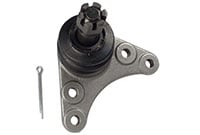Ball Joints & Tie Rod Ends: What Your Toyota Ride Needs
Got steering issues? Whether you’re fixing up your car or restocking your shop, our tie rod ends are what you need. Made for Toyota and Renault vehicles, these precision-engineered components keep your ride smooth, sharp, and steady. Oh, and in case you’re wondering about ball joints and tie rod ends, yeah, we’ll explain that too.
What Are You Working on Today
- Tuning up your daily driver?
- Modding a muscle car?
- Stocking parts for your shop?
Whatever’s on your list, our tie rod ends have you covered. Perfect for domestic trucks, SUVs, muscle cars—basically anything that needs precise steering and a solid suspension.
Ball Joints and Tie Rod Ends – What’s the Difference
Here’s the deal:
| Feature | Tie Rod Ends | Ball Joints |
| Function | Connect steering rack to wheels | Connect control arms to steering knuckles |
| Role | Precision steering | Suspension movement |
Where Are Ball Joints and Tie Rod Ends Located
Quick map check:
- Tie Rod Ends: They’re part of the steering system, between the steering rack and the wheels.
- Ball Joints: Found in the suspension system, connecting the control arms to the steering knuckles.
Not hard to find if you’re under the car.
What Do Tie Rod Ends Do
They make steering precise, smooth, and responsive. Without them, your wheels won’t turn the way you want—kind of a big problem, right? If they’re worn out, steering gets sloppy or stiff. Either way, it’s time to replace.
Common Causes of Tie Rod End Failure
Wondering why tie rod ends fail? Here are the usual culprits
- Normal Wear and Tear
Daily driving takes its toll over time. - Poor Road Conditions
Potholes and uneven roads don’t help. - Improper Installation
A botched install can speed up wear.
Regular maintenance and using quality parts like ours can help avoid these issues.
How to Inspect Your Tie Rod Ends and Ball Joints
Don’t wait for a mechanic—here’s how to check them yourself:
- Visual Check
Look for grease leaks, cracks, or worn rubber boots.
- Play Test
Grab the tie rod and give it a wiggle—excess play is a red flag. - Listen
Turn the steering wheel and listen for clunks or squeaks.
Spot issues? Replace them before things get worse.
Signs It’s Time to Replace Tie Rod Ends
Here’s how to know your tie rod ends are calling it quits:
| Sign of Failure | Possible Cause | Recommended Action |
| Stiff or unresponsive steering | Worn tie rod ends | Replace tie rod ends |
| Uneven tire wear | Misalignment | Replace tie rods, realign wheels |
| Clunking noises | Loose or damaged parts | Inspect and replace as needed |
Ignoring these signs? Bad idea. Fix it before it gets worse.
Can You Drive with Worn Tie Rod Ends
Technically, yes—for a bit. But should you? Nope. Driving with worn tie rod ends can:
- Mess up your alignment.
- Wear out your tires faster.
- Put you at risk of steering failure.
Play it safe. Replace them ASAP.
How Tie Rod Ends Impact Vehicle Alignment
Bad tie rod ends can wreak havoc on your alignment. Misalignment causes uneven tire wear, poor handling, and even steering drift. Regular checks and timely replacements keep your car running straight and true.
Premium Materials Built for Performance
We don’t do cheap stuff. Our tie rod ends are made from the best:
| Material | Benefit |
| SWRM6K Steel | High strength for durability |
| Polyethylene (PE) | Reduces wear, ensures smooth performance |
| Chloroprene Rubber (CR) | Weatherproof, flexible for any condition |
| SAE1018 Steel | Reliable for standard applications |
| SCM440 Steel | Handles high-pressure conditions |
Need custom specs? No problem. Tell us what you need, and we’ll make it happen.
DIY Replacement: How to Change Tie Rod Ends
Feeling handy? Here’s how to replace your tie rod ends:
- Jack It Up: Lift the car and secure it with jack stands.
- Loosen It: Remove the old tie rod ends using the right tools.
- Install New Ones: Screw in the replacements, ensuring proper alignment.
Take it for a test drive, then get a professional alignment check to be safe.
Why Businesses Love Our Tie Rod Ends (B2B)
For auto shops, distributors, and retailers, here’s why we’re the real deal:
| Feature | Benefit for Businesses |
| Low MOQ | Small shops can start with just 30 pcs |
| Bulk Discounts | Cost savings for larger orders |
| Reliable Delivery | Keeps your operations running smoothly |
| Durable Parts | Fewer returns, happier customers |
Why Car Owners Trust Us (B2C)
For the DIY crowd and car enthusiasts, here’s why you’ll love our tie rod ends:
- Affordable Quality: Great parts without emptying your wallet.
- Easy Installation: OE replacement means no headaches—just install and go.
- Built to Last: These parts can take daily wear, bumps, and sharp turns like pros.
Why Your Steering Wheel Feels Hard to Turn
Blame the tie rod ends. When they’re worn out, steering gets stiff. Replace them, and your car will steer like it’s supposed to—smooth and easy.
Upgrade Your Steering with Great Auto Parts
Looking for premium Toyota and Renault tie rod ends? Look no further than Great Auto Parts. We’re trusted by businesses and car enthusiasts for delivering durable, high-quality parts that perform.
- For businesses: Take advantage of low MOQs, bulk discounts, and custom options.
- For car owners: Enjoy affordable prices and easy installation with parts built to last.
Get your hands on the best ball joints and tie rod ends today!






